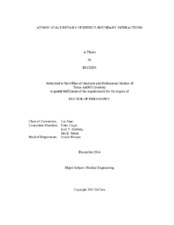| dc.description.abstract | The study is aimed to understand atomic scale details of defect-boundary interactions, which are critical to develop radiation tolerant fuel cladding materials for harsher neutron environments. By means of molecular dynamics simulations, we addressed the key questions of (1) how defects are trapped by a grain boundary, (2) how defect are annihilated at a grain boundary, and (3) what are upper limits of radiation tolerance of boundary-engineered metals. The modeling is performed by using large-scale atomic/molecular massively parallel simulator (LAMMPS) code and pure Fe is selected as the model material.
For mechanism of defect tapping towards a grain boundary, we find that, instead of the general consensus that the trapping is caused by biased defect diffusions due to relatively lower defect formation energies at a grain boundary, long range defect migration is realized by creation of chain like defects. A chain is induced by the stress field around a defect, and is formed by pushing its immediate lattice atom neighbor into an interstitial site. This newly formed interstitial can induce formation of another vacancy-interstitial pair along the chain direction. The process is repeated or simultaneously occurs along the chain. Thus, a chain consists of alternately positioned interstitials and vacancies. The subsequent defect annihilation between neighboring defects on the chain leads to the defect transport. We identify three types of defect transport models which involve different chains.
For mechanism of defect annihilation on a grain boundary, we find that both defect transport and interstitial-vacancy recombination are realized by formation of similar chain-like defects. The vacancy and interstitial along the chain correspond to the sites of their corresponding formation energy minima, thus the capability to form such chains is determined by the patterns of boundary defect formation energies. For a boundary of small misorientation angle, chain formation is allowed to occur in one direction only and all chains are parallel to each other. At large angles, however, chains are so close to each other that new allowable chain directions are created by linking patterns from different chains. This suggests that large angle boundaries are more efficient to move and recombine defects. The modeling further calculates the energy barriers for chain-mediated defect recombination under different boundary configurations.
These findings lead to the conclusion that defect sink strengths of grain boundaries are determined by not only the efficiency to transport to boudnaries, but also the efficiency to recombine boundary defects. Otherwise, the difficulty to remove defects will quickly turn of the sink property. This is confirmed by comparing the width of defect denuded zone created around a boundary, in a cell randomly bombarded by Fe self-ions to different damage levels. A large angle boundary is more preferred to achieve maximum radiation tolerance. | en |


